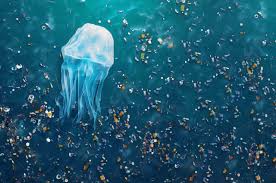Plastic pollution is a persistent and widespread issue, invading ecosystems around the world and lingering in the environment for decades. Microplastics, in particular, provide considerable issues due to their small size and extensive dissemination. A recent study has highlighted the potential role insects could play in tackling the environmental crisis, pointing to a fresh, nature-inspired solution.
The Rising Threat of Microplastics
Microplastics are small plastic particles less than five millimeters long that are formed by the breakdown of bigger plastic trash or are discharged as primary microplastics, such as microbeads used in personal care products. These particles have been found in oceans, rivers, soils, and even in the air we breathe. Microplastics endanger marine and terrestrial ecosystems while also posing health hazards to humans and animals.
Traditional means of combating plastic pollution, such as recycling and trash management, have proven inadequate. As scientists investigate novel ways, the concept of utilizing live organisms to break down plastics has gained traction.
Insects: Nature’s Cleanup Crew
Insects are some of the world’s most effective scavengers and decomposers, able to survive in severe environments and feed on a variety of foods. Researchers have been particularly interested in mealworms, the larval stage of the darkling beetle, because of their propensity to devour and digest plastic.
Dr. Michelle Tseng, a zoologist at the University of British Columbia (UBC), and her study team have looked into mealworms as potential partners in the fight against microplastic pollution. Previous research demonstrated that insects may consume and absorb microplastics in extreme, food-scarce environments. However, these situations have limited practical use in real-world ecosystems.
Testing Mealworms under Realistic Conditions
To address this gap, Dr. Tseng and UBC graduate Shim Gicole devised an experiment that replicated a more realistic atmosphere. The researchers offered mealworms a diet rich in microplastics and bran, a nutritious and enticing food source. They employed ground-up disposable face masks, a typical plastic product that contributed to pandemic-era contamination, as a source of microplastic.
The study, published in Biology Letters, followed mealworms for 30 days. The insects devoured around half of the microplastics given, with an average of 150 particles per mealworm. Surprisingly, the mealworms not only survived but even gained weight, demonstrating that the plastic-laden food had no negative impact on their growth or overall health.
Where Does Microplastics Go?
One of the study’s most significant discoveries was how mealworms processed the microplastics they devoured. A small percentage of the particles, perhaps four to six per milligram of waste, were expelled. The remaining microplastics were either ingested by the mealworms or broken down during digestion.
The particular mechanisms by which mealworms degrade polymers remain unknown. However, the findings indicate that their digestive systems may provide useful insights toward combating plastic waste. If these systems can be understood and replicated on a wider scale, they may pave the door for novel biotechnology solutions.
Potential Applications for Plastic-Eating Bugs
These discoveries have serious ramifications. Mealworms and other plastic-consuming insects could help manage plastic trash in controlled situations. For example:
- Plastic Waste Facilities: Insects could be used to decompose plastics before they enter landfills or rivers.
- Biodegradation Technologies: By researching the enzymes and intestinal microbes involved in plastic digestion, scientists could create synthetic or manufactured solutions to speed up plastic disintegration.
- Integrated Waste Management: Combining insect-based solutions with traditional recycling and waste reduction initiatives may increase overall efficiency.
The Function of the Gut Microbes & Enzymes
Scientists believe that the capacity of mealworms to digest plastic derives from bacteria in their intestines. Enzymes produced by these bacteria may degrade plastic polymers into smaller, more manageable components. Understanding these enzymes could open up new opportunities for industrial-scale uses.
Attempts are already underway to find and isolate these enzymes. If successful, these biological tools could be used to better treat plastic garbage, potentially converting it into harmless byproducts or even reusable materials.
Environmental and Ethical Considerations
While the idea of utilizing insects to reduce plastic pollution is appealing, it raises various ethical and environmental concerns:
- Impact on Ecosystems: The large-scale use of insects for plastic breakdown may unintentionally affect local ecosystems or introduce invasive species.
- Waste Byproducts: The byproducts of insect digestion of plastic must be investigated to guarantee that they do not pose extra environmental risks.
- Ethical Concerns: The widespread breeding and usage of insects for trash control may generate ethical concerns, particularly among animal rights activists.
Addressing these problems would necessitate careful planning and thorough research to guarantee that the benefits outweigh the hazards.
A Call to Re-evaluate Insect Roles
Dr. Tseng underlines the need to reconsider our interactions with insects. “Perhaps we can start viewing bugs as friends,” she suggests. Humans routinely use pesticides to kill millions of insects, often without regard for their ecological benefits. By adjusting our mindset, we can use these creatures’ potential to address serious environmental concerns.
Scaling Up: The Road Ahead
The next steps involve expanding the research to see if mealworms’ plastic-degrading skills may be used on a wider scale. Key areas of attention are:
- Optimizing Diets: Finding combinations of plastic and organic food sources that improve breakdown efficiency.
- Enhancing Microbial Action: Investigating techniques to boost the activity of plastic-degrading gut microorganisms.
- Developing Biotechnologies: Using mealworm digestive knowledge to create designed waste management solutions.
Collaboration among biologists, engineers, and environmental scientists will be critical to turning this promising research into practical solutions.
Conclusion
The fight against microplastic pollution necessitates novel and diverse approaches. Plastic-eating insects such as mealworms demonstrate nature’s latent capacity to solve human-caused issues. Learning from these organisms allows us to build long-term solutions to reduce plastic waste and maintain our planet’s ecosystems.
While the concept of insects as environmental partners may appear unorthodox, it highlights a larger truth: nature frequently holds the answers to humanity’s most difficult issues. As research progresses, mealworms and their microscopic companions may prove to be an important part of the answer to the worldwide plastic catastrophe.

